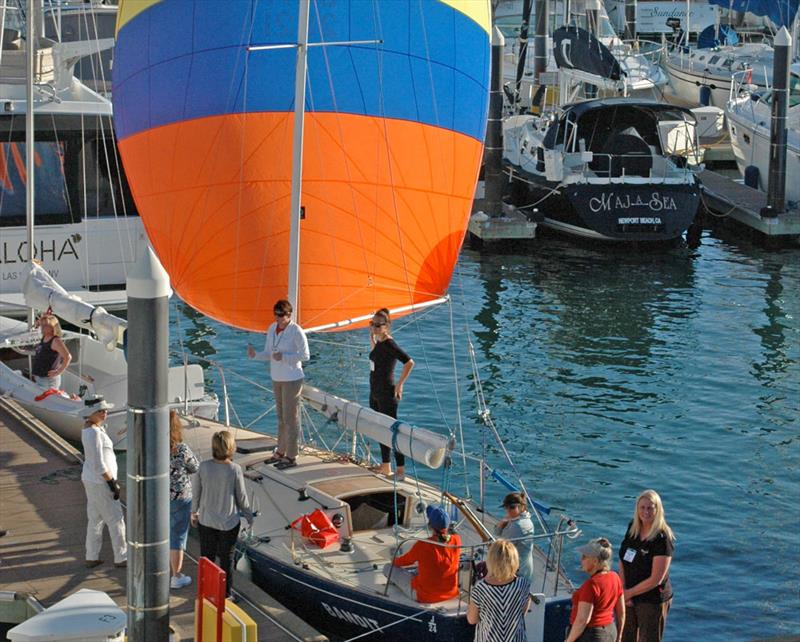
An interview with Gail Hine about the 2018 Sailing Convention for Women
by David Schmidt 1 Feb 2018 16:00 GMT
February 3, 2018

Students learn to rig spinnakers at the Sailing Convention for Women © Sailing Convention for Women
While we sailors like to bill ourselves as a welcoming and friendly subset of the human race, the simple fact remains that there are more men involved in the sport, especially on the racing side, than there are women. While this ratio has been improving in recent years thanks in part to high-profile initiatives and accomplishments such as The Magenta Project; Team SCA’s solid performance in the 2014/2015 Volvo Ocean Race (VOR); the women who are currently contributing handsomely to their teams in the 2017/2018 VOR, and the mixed-sex Nacra 17 Olympic event, there’s still plenty of room for improvement. Fortunately, forward-thinkers such as Gail Hine, founder of the Sailing Convention for Women, have been addressing this issue on the grassroots level for years.
Hine started creating what has evolved to become the Sailing Convention for Women in 1975, and since then she and her team of instructors have helped countless women learn the brass-tack skills needed to safely and successfully run cruising sailboats, including dealing with unforeseen mishaps ranging from engine woes to rigging issues.
While most of the curriculum is aimed at inshore and offshore cruising, this material is all part of the time-honored bedrock material that every great sailor, male or female, needs to understand before commanding a keelboat in any sort of serious offshore or distance-racing event.
This year’s Sailing Convention for Women is set to unfurl on February 3 at the Bahia Corinthian Yacht Club in Newport Beach, California, so I caught up with Hine, via email, to learn more.
Can you give us an overview of the Sailing Convention for Women?
The all-day format of both land-based and on-the-water based workshops in subjects specifically targeted toward women have been especially important, with the nucleus workshop called “Suddenly Singlehanded” [being] one of [our] most popular and important offerings over the years.
The [Sailing Convention for Women] consists of four workshops sessions (13 land-based subjects, three water-based in AM; with 13 land-based subjects, three water-based in PM).
The event includes a hearty breakfast, lunch, happy hour, and served, platted dinner; a featured, interesting, inspirational speaker at dinner; a hugh raffle gifts presentation. Some very popular and critical workshops are repeated each year; new ones are often created by our presenters.
How has the Sailing Convention for Women grown and evolved over the years? Can you give us an example or two?
The WSC started small with about 100-125 people in the first three years at Cabrillo Beach YC. Then [I] moved to Orange County – Bahia Corinthian Yacht Club where the larger facilities could accommodate up to 300; average attendance is about 225 [women].
Historically, what are the biggest take-away benefits that attendees realize from their time at the Sailing Convention for Women?
The biggest take aways are the kudos received, and what each person gets from her attendance at the event. And the quality of the instructors and their dedication to volunteer to come to give of their expertise and knowledge to the gals. They are such an inspiration to everyone.
What are the most popular workshops, and have you seen this popularity move over the years?
Our most popular workshops are Docking; Suddenly Singlehanded; Weather; Basic Nav101-102; Nightime Nav; recently, Emergency Equipment Demo, [the later of which was] first offered in 2017.
In your mind, what are the best attributes to the instructors at the Sailing Convention for Women, and how do you think their approach differs from that offered at a mixed-sex sailing course?
Capt. Alison Osinksi creates four specialty Navigation workshops, from basics with paper charts to iPad and introduction to new electronic nav equipment for this event.
A couple of years ago, Capt. Patty Cook revamped our Suddenly Singlehanded workshop into an interactive session. After an introduction, she had the class of some 50 women, [whom she broke] up into groups of 5 to evaluate, solve and prevent a difficult to catastrophic scenario. She had ten different scenarios, most taken from her own 50 years of experience, from sailing a 24-foot boat with two sons; trailering across the country, to big-boat cruising.
We are so lucky to have a truly outstanding team of wonderful women sailors who are willing to give so much more back to other women so that they can get even more out of this wonderful recreational and instructional experience!